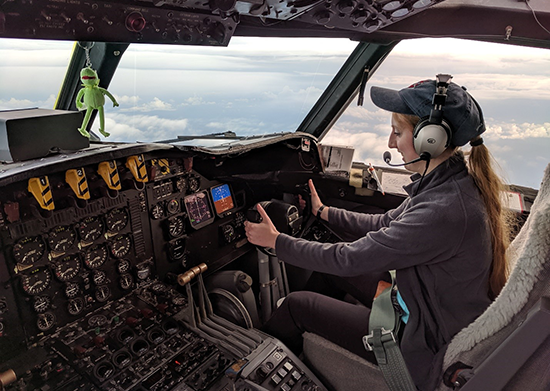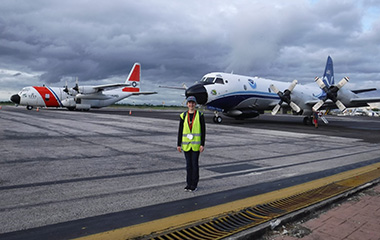DAES Student Takes Flight for Science to Study Tropical Cloud Formation
 |
|
DAES student Emily Paltz flies Kermit – the NOAA42 P-3 Hurricane Hunter – during the OTREC field campaign. (Photo by Brian Richards)
|
ALBANY, N.Y. (Nov. 5, 2019) – When a group of scientists from the National Center for Atmospheric Research (NCAR) Earth Observing Laboratory visited campus last semester, Emily Paltz jumped at the opportunity to meet and network with them.
She never imagined their conversation would lead to her climbing aboard a NOAA hurricane hunter.
Paltz, a PhD student in the Department of Atmospheric and Environmental Sciences (DAES), was among a select group invited to join the Organization of Tropical East Pacific Convection, or OTREC, international field campaign.
Led by two professors from New Mexico Tech, OTREC brought together dozens of scientists, students and government officials from the United States, Costa Rica and Colombia. Their goal was to better understand the processes that lead to the formation of convection (thunderstorms) in the East Pacific and southwestern Caribbean.
The group was stationed in Costa Rica from Aug. 5 through early October.
“Our department invited a group of scientists to campus from NCAR who provide and maintain research equipment for the NSF,” Paltz said. “I grabbed lunch with them and expressed my interest in participating in a field campaign. Shortly after, I received an email from one of them about OTREC and jumped at the chance to join.”
 |
|
Paltz stands in front of a United States Coast Guard plane and Kermit – the NOAA42 P-3 Hurricane Hunter. (Photo by Justin Whitaker)
|
While in Costa Rica, the OTREC team flew on the NCAR/NSF Gulfstream V aircraft to deploy over 600 dropsondes — instruments used to measure weather variables including temperature, humidity, pressure and wind, from the plane to the ocean. They also launched additional radiosondes from the ground in both Costa Rica and Colombia.
Paltz spent several weeks on the campaign, working closely with OTREC’s radar scientists to observe data from the HIAPER Cloud Radar (HCR) and troubleshoot equipment errors. She not only had the opportunity to ride in the Gulfstream V, but also fly a NOAA hurricane hunter when a weather system in the region was flagged with potential to form into a tropical cyclone.
Prior to the field campaign, Paltz had never flown in a research aircraft.
“The hurricane hunter flights were not planned. A threatening weather system was being tracked by NOAA near our region, and we were asked to help observe,” said Paltz, who plans to pursue a career as a research scientist, professor or member of the NOAA Corp. after earning her UAlbany degree. “Flying through the storm was like being a little kid at Disney World. Riding on a hurricane hunter is something I have dreamed of doing for years.”
Results from the OTREC study are being analyzed and will be presented at the American Meteorological Society Conference on Hurricanes and Tropical Meteorology next spring to help scientists better understand the physics of storms.
You can learn more about the project here.
![]() For more news, subscribe to UAlbany's RSS headline feeds
For more news, subscribe to UAlbany's RSS headline feeds
A comprehensive public research university, the University at Albany-SUNY offers more than 120 undergraduate majors and minors and 125 master's, doctoral and graduate certificate programs. UAlbany is a leader among all New York State colleges and universities in such diverse fields as atmospheric and environmental sciences, business, education, public health,health sciences, criminal justice, emergency preparedness, engineering and applied sciences, informatics, public administration, social welfare and sociology, taught by an extensive roster of faculty experts. It also offers expanded academic and research opportunities for students through an affiliation with Albany Law School. With a curriculum enhanced by 600 study-abroad opportunities, UAlbany launches great careers.


